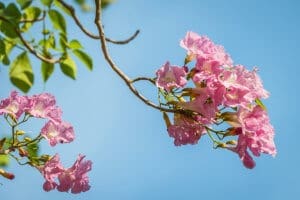Pau de Arco is an enormous canopy tree filled with delicate orchid like flowers. Proudly rooted in the Amazon rainforest, Pau d’Arco is part of the Tabebuia genus of trees, with the two types most commonly used; Tabebuia heptaphylla and Tabebuia impetiginosa. In South America, the tree is more commonly referred to as taheebo (“tree of godly grace”) or lapacho.1 Because of its chemical constituents, the shredded bark has been an important ingredient in the ancient pharmacopeia of indigenous Brazilians, and today is widely used by all populations of North and South America.
The Botanical
 These deciduous trees grow between 10 to 30 feet tall and boast wide trunks. Before the trees fill with deep green leaves in the spring; delicate, pink, trumpet-shaped flowers with yellow throats fill their branches. Those flowers continue to radiate beauty through the spring and into early summer.2 Today, many people who live in the cities of South America choose to plant Tabebuia trees in their yards as a common landscaping plant. In fact, the lapacho tree is the national tree of Paraguay.3
These deciduous trees grow between 10 to 30 feet tall and boast wide trunks. Before the trees fill with deep green leaves in the spring; delicate, pink, trumpet-shaped flowers with yellow throats fill their branches. Those flowers continue to radiate beauty through the spring and into early summer.2 Today, many people who live in the cities of South America choose to plant Tabebuia trees in their yards as a common landscaping plant. In fact, the lapacho tree is the national tree of Paraguay.3
Historic Use
Indigenous people appreciated the wood of Pau d’Arco for its strength. Because many tribes commonly used the wood to make hunting bows, they originally referred to the tree as “bow stick” and “bow stem.” The Guarani and Tupi Indians named the tree “tajy” because they relied on it as a source of “strength and vigor.” These tribes used Pau d’Arco bark as a health tonic and believed the wood not only helped the human body, but that it would bring strength and vigor to their hunting bows.4
Modern Cultivation
Not only is the wood strong and hearty, the chemical composition of the wood is also rich with novel compounds.5 Specifically, these chemicals constituents are called naphthoquinones: lapachol and beta-lapachone.6 The tree is so beautiful it is now widely grown in tropical regions of Asia, Middle east and warmer regions of the USA. The wood is an important material used in construction. Harvested wood is commonly referred to as ipê, and is often exported to North America for use in boardwalks, residential decking, and flooring.7
Visit Herbs America Online to Learn More about Pau d’Arco
Explore various natural supplements the native Amazon tribes have used for centuries at Herbs America in our online store. Pau d’Arco is available HERE as liquid extract, or you may choose to purchase it in its raw, botanical form at THIS LINK.
Learn more and save more!
Stay up-to-date on the latest specials, news, and information from Herbs America. Sign up to receive our newsletter and receive 15% off your first order! CLICK HERE to get started!
“Pau D’arco.” Gale Encyclopedia of Alternative Medicine. Retrieved October 16, 2020 from Encyclopedia.com: https://www.encyclopedia.com/medicine/encyclopedias-almanacs-transcripts-and-maps/pau-darco ↩
Maier, Casandra. “What is a Lapacho Tree?” SFGATE.com, published online at: https://homeguides.sfgate.com/lapacho-tree-48569.html ↩
Taylor, Leslie. “Pau d’Arco.” The Healing Power of Rainforest Herbs. 2005. Published online at: https://rain-tree.com/paudarco.htm. ↩
Taylor, Leslie. “Pau d’Arco.” The Healing Power of Rainforest Herbs. 2005. Published online at: https://rain-tree.com/paudarco.htm. ↩
“Pau d’arco.” Wake Forest Baptist Health. Published online at: http://wakehealthse3.adam.com/content.aspx?productid=107&pid=33&gid=000268#:~:text=Pau%20d’arco%20contains%20chemical,amounts%20of%20the%20antioxidant%20quercetin. ↩
Maier, Casandra. “What is a Lapacho Tree?” SFGATE.com, published online at: https://homeguides.sfgate.com/lapacho-tree-48569.html ↩
Schulze, Mark; Grogan, James; Uhl, Chris; Lentini, Marco; Vidal, Edson. 2008. Evaluating ipe (Tabebuia, Bignoniaceae) logging in Amazonia: sustainable management or catalyst for forest degradation? Biological Conservation. 141: 2071-2085. ↩

Reader Interactions